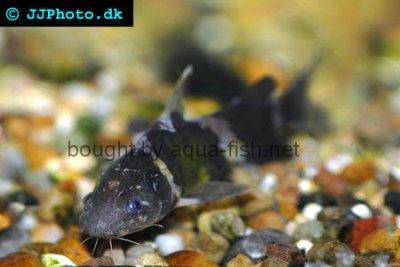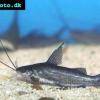Asian bumblebee catfish - Pseudomystus siamensis
Scientific name: Pseudomystus siamensis
Common name: Asian bumblebee catfish
Family: Bagridae
Usual size in fish tanks: 10 - 15 cm (3.94 - 5.91 inch)
014
Recommended pH range: 6.4 - 7.2
Recommended water hardness: 4 - 15°N (71.43 - 267.86ppm)
0°C 32°F30°C 86°F
Recommended temperature range: 22 - 27 °C (71.6 - 80.6°F)
The way how these fish reproduce: Spawning
Where the species comes from: Southeast Asia
Temperament to its own species: peaceful
Temperament toward other fish species: aggressive to smaller
Usual place in the tank: Bottom levels
Short description
Pseudomystus siamensis is a stout, banded bagrid catfish known for its contrasting “bumblebee” pattern and nocturnal habits. It’s shy by day and becomes active after lights-out. Provide many dark retreats or you’ll see territorial disputes (often announced by audible croaking sounds). With space and cover it can be kept in small groups.
Minimum tank size & aquascape
- Minimum tank: 150–200 L (≥100–120 cm length) for a small group; a single can live in ~90 L, but group housing is richer behaviorally.
- Layout: Fine sand or smooth gravel; tangle of driftwood roots, rock caves, inert tubes (black PVC/ceramic) and leaf litter to break sightlines and assign territories.
- Lighting & flow: Subdued lighting with dim corners; gentle to moderate flow and high oxygenation.
Water parameters
Stable, clean water matters more than chasing exact numbers. Keep pH near neutral (6.4–7.4), soft to medium hardness, temperature 22–27 °C. Perform regular water changes (25–40 % weekly) and maintain good mechanical filtration to keep detritus off the substrate.
Diet (Food & feeding)
A carnivore that readily adapts to quality sinking pellets and wafers after settling in. Offer a varied mix of frozen/live foods (bloodworms, blackworms, chopped earthworms, mysis, small prawns) a few evenings per week. Feed at dusk or after lights-out to ensure timid individuals eat. Avoid: over-reliance on fatty meats and feeder fish (health and disease risks).
Behavior & compatibility
- Conspecifics: Provide multiple hides (one per fish spares) to prevent bickering; groups are workable in spacious, structured tanks.
- Tank mates: Peaceful, similarly sized species that are not bite-sized: medium rasboras/barbs (non-nippy), rainbowfish, larger tetras, robust loaches (Botia/Yasuhikotakia—watch for boisterous species), and armored catfish that occupy different niches.
- Avoid: Tiny fish and shrimp (prey), long-finned slow fish, and aggressive cichlids that may harass nocturnal catfish.
Sexing
Females are typically deeper-bodied and heavier when mature; males stay slimmer. External differences are subtle—venting is more reliable for experienced keepers.
Breeding
Home-aquarium breeding is rare and undocumented without hormonal induction. They are presumed cave/substrate spawners in nature. If attempting, use a large, mature tank with very dim light, soft to medium water, abundant caves/tubes, and heavy conditioning on live/frozen foods. Remove adults after spawning if eggs appear, and rear fry on tiny live foods.
Plants (region-compatible)
Hardy, shade-tolerant plants that tolerate cover and leaf litter: Cryptocoryne spp., Microsorum pteropus (Java fern), Anubias spp., and floating plants (Salvinia, Pistia) to diffuse light.
Care level
Moderate. Success hinges on providing numerous hides, subdued lighting, and a nighttime feeding routine. In suitable conditions it’s a durable, characterful catfish.
Notes
Often confused with other Pseudomystus species in the trade. Verify patterning and locality when possible; size expectations and temperament vary across the complex.
Pictures
Bought by aqua-fish.net from jjphoto.dk.




 Mystus
Mystus  Mystus
Mystus